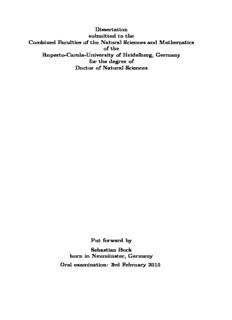
Non-Equilibrium Time Evolution of an Anderson Quantum Dot in the Kondo Regime PDF
Preview Non-Equilibrium Time Evolution of an Anderson Quantum Dot in the Kondo Regime
Dissertation submitted to the Combined Faculties of the Natural Sciences and Mathematics of the Ruperto-Carola-University of Heidelberg, Germany for the degree of Doctor of Natural Sciences Put forward by Sebastian Bock born in Neumünster, Germany Oral examination: 3rd February 2015 Non-Equilibrium Time Evolution of an Anderson Quantum Dot in the Kondo Regime Referees: Prof.Dr.Thomas Gasenzer Prof.Dr.Selim Jochim Sebastian Bock Institut für Theoretische Physik Philosophenweg 16 D-69120 Heidelberg Germany Supervisor Prof.Dr.Thomas Gasenzer Institut für Theoretische Physik Philosophenweg 16 D-69120 Heidelberg Germany Abstract In this thesis, we use a functional quantum field theoretical approach to investigate the non-equilibrium time evolution of an Anderson quantum dot with the main focus on the Kondo regime. We employ a real-time Keldysh path integral formulation to find an effective action. From the two-particle irreducible effective action, we derive, from the variational principle, the exact real-time Kadanoff–Baym equations of mo- tionforthefullpropagator. Westudythesedynamicequationsforthesingleimpurity Anderson model, which decribes a quantum dot coupled to two finite-temperature leads. We take the tunnelling to the leads into account exactly. In order to solve the Kadanoff–Baym equations numerically we have to approximate them. For this purpose, we make a non-perturbative approximation by summing an infinite number of Feynman diagrams in the direct (s)-, particle-particle (t)-, particle-hole (u)-, and stu-channels. The aim of our investigation is to analyse the non-equilibrium real- time evolution of the quantum dot after a hybridisation and interaction quench into its stationary state. The main focus is on the narrowing of the Kondo resonance and the formation of the Hubbard side bands. Following on from this, the main achievement is the transient, as well as the stationary electrical current, through the quantum dot and the investigation of the dependence on temperature and magnetic field. We compare our results with other methods, such as functional renormalisation group and iterative sum of path integrals, and find a very good agreement in most situations. v Kurzzusammenfassung In der vorliegenden Arbeit wird ein funktionaler quantenfeldtheoretischer Zugang verwendet,umdieNichtgleichgewichtszeitentwicklungeinesAnderson-Quantenpunk- tes insbesondere im Kondo-Regime zu untersuchen. Es wird eine Pfadintegralformu- lierung unter Benutzung des Keldysh-Realzeitformalismus verwendet, um eine ef- fektive Wirkung herzuleiten. Unter Verwendung des Variationsprinzips werden die exakten Kadanoff–Baym-Bewegungsgleichungen in Realzeit für den vollen Propaga- tor aus der zweiteilchen-irreduziblen Wirkung abgeleitet. Die Bewegungsgleichungen werden für das single impurity Anderson-Modell, welches einen Quantenpunkt mit zwei angekoppelten Wärmebädern bei endlicher Temperatur beschreibt, untersucht. Die auftretenden Tunnelprozesse werden exakt berücksichtigt. Damit die Kadanoff– Baym-Gleichungen numerisch gelöst werden können, muss eine Näherung vorge- nommen werden. Hierzu wird eine nichtstörungstheoretische Näherung gewählt, bei der eine unendliche Anzahl von Feynman-Diagrammen im Direkten (s)-, Teilchen- Teilchen (t)-, Teilchen-Loch (u)- und stu-Kanal aufsummiert wird. Das Ziel dieser Arbeit ist die Nichgleichgewichts-Realzeitentwicklung eines Quantenpunktes nach ei- nem Hybridisierungs- und Wechselwirkungsquench in seinen stationären Zustand zu untersuchen. Das Hauptaugenmerk liegt auf der Beobachtung der Verschmälerung der Kondo-Resonanz und der Bildung der Hubbard-Seitenpeaks. Darüber hinaus wird der transiente sowie der stationäre elektrische Strom durch den Quantenpunkt unddessenÄbhangigkeitvonTemperaturundMagnetfeldbetrachtet.DieErgebnisse werden mit anderen Methoden, wie der funktionalen Renormierungsgruppe und der iterativen Summierung von Pfadintegralen verglichen, wobei in den meisten Fällen eine sehr gute Überstimmung gefunden wird. vi Declaration by Author This thesis is composed of my original work, and contains no material previously published or written by another person except where due reference has been made in the text. I have clearly stated the contribution by other authors to jointly-authored worksthatIhaveincludedinmythesis. Thecontentofmythesisistheresultofwork I have carried out since the commencement of my graduate studies at the Heidelberg Graduate School of Fundamental Physics, Institut für Theoretische Physik, Uni- versität Heidelberg and does not include material that has been submitted by myself to qualify for the award of any other degree or diploma in any university or other tertiary institution. vii 獻給 慧 ix
Description: